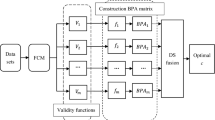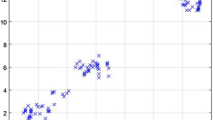Abstract
The cluster validity function is used to evaluate the quality of the cluster results, and giving the exact number of initial cluster categories will rationalize the cluster results. Most single cluster validity functions and combined cluster validity functions generally have strong subjective problems, which also increases the burden on decision analysts and have great limitations in applications. To overcome the shortcomings of these clustering validity functions and improve the accuracy of the optimal cluster category classification for the datasets, based on the clustering performance evaluation components, a validity functional component construction method based on the exponential and log form was proposed. The weighting method adopts the combination of expert empowerment and standard separation method to combine the five weights so as to obtain 52 different fuzzy clustering validity functions. Then, based on the fuzzy C-mean (FCM) clustering algorithm, the performance analysis are carried out by using multiple data sets. Experimental simulation of these functions are proceeded on six commonly used UCI datasets. A clustering validity function with the simplest structure and the best classification effect was selected by comparison. Finally, this function is compared with 8 typical single clustering validity functions and four common clustering validity combination evaluation methods on 8 UCI data sets. Through experimental simulation, the proposed validity function is compared in processing data sets, but also has strong scientific theoretical basis. Thus, the feasibility and effectiveness of the proposed clustering validity function construction method are proved.











Similar content being viewed by others
References
Leung, S.H., Wang, S.L., Lau, W.H.: Lip image segmentation using fuzzy clustering incorporating an elliptic shape function. IEEE Trans. Image Process. 13(1), 51–62 (2004)
Lu, J., Yuan, X., Yahagi, T.: A method of face recognition based on fuzzy c-means clustering and associated sub-NNs. IEEE Trans. Neural Netw. 18(1), 150–160 (2007)
Wang, Y.H., Zhao, H.C.: PolSAR image segmentation by mean shift clustering in the tensor space. Acta Automatica Sinica 36(6), 778–806 (2010)
Hung, W.L., Yang, M.S., Chen, D.H.: Bootstrapping approach to feature-weight selection in fuzzy c-means algorithms with an application in color image segmentation. Pattern Recogn. Lett. 29(9), 1317–1325 (2008)
Maulik, U., Saha, I.: Automatic fuzzy clustering using modified differential evolution for image classification. IEEE Trans. Geosci. Remote Sens. 48(9), 3503–3510 (2010)
Sulaiman, S.N., Isa, N.A.M.: Adaptive fuzzy-K-means clustering algorithm for image segmentation. IEEE Trans. Consum. Electron. 56(4), 2661–2668 (2010)
Tung, F., Wong, A., Clausi, D.A.: Enabling scalable spectral clustering for image segmentation. Pattern Recogn. 43(12), 4069–4076 (2010)
Yang, S.Y., Wu, R.X., Wang, M., Jiao, L.C.: Evolutionary clustering based vector quantization and SPIHT coding for image compression. Pattern Recogn. Lett. 31(13), 1773–1780 (2010)
Wang, Z.M., Song, Q., Sohf, Y.C., Sim, K.: Robust curve clustering based on a multivariate t-distribution model. IEEE Trans. Neural Netw. 21(12), 1976–1984 (2010)
Liu, P.X., Meng, M.Q.H.: Online data-driven fuzzy clustering with applications to real-time robotic tracking. IEEE Trans. Fuzzy Syst. 12(4), 516–523 (2004)
Celikyilmaz, A., Turksen, I.B.: Enhanced fuzzy system models with improved fuzzy clustering algorithm. IEEE Trans. Fuzzy Syst. 16(3), 779–794 (2008)
Hyong-Euk, L., Kwang-Hyun, P., Bien, Z.Z.: Iterative fuzzy clustering algorithm with supervision to construct probabilistic fuzzy rule base from numerical data. IEEE Trans. Fuzzy Syst. 16(1), 263–277 (2008)
Goldberger, J., Tamir, T.: A hierarchical clustering algorithm based on the Hungrian method. Pattern Recogn. Lett. 29(11), 1632–1638 (2008)
Bezdek, J.C.: Pattern Recognition with Fuzzy Object Algorithms, pp. 54–57. Plenum Press, New York (1981)
MacQueen J.: Some Methods of Classification and Analysis of MultiVariate Observations. Proc of Berkeley Symposium on Mathematical Statistics and Probability, 281–297 (1967).
Yodern, J., Priebe, C.E.: Semi-supervised K-means++. J. Stat. Comput. Simul. 87(13), 2597–2608 (2017)
Geng, Z., Chengchang, Z., Huayu, Z.: Improved K-means algorithm based on density Canopy. Knowl.-Based Syst. 145, 289–297 (2018)
Hiep, N.H.: Privacy-preserving mechanisms for k-modes clustering. Comput. Secur. 78, 60–75 (2018)
J. C. Bezdek, N. R. Pal.: Some new indexes of cluster validity. IEEE Transactions on Systems, Man and Cybernetics, Part B(Cybernetics), 28(3), 301–315 (1998).
D. A. Simovici, S. Jaroszewicz.: An axiomatization of partition entropy. IEEE Transactions on Information Theory, 48(7), 2138–2142 (2002).
Silva, L., Moura, R., Canuto, A.M.P., Santiago, R.H.N., Bedregal, B.: An Interval-Based Framework for Fuzzy Clustering Applications. IEEE Trans. Fuzzy Syst. 23(6), 2174–2187 (2015)
Chen, M.Y., Linkens, D.A.: Rule-base self-generation and simplification for data-driven fuzzy models. Fuzzy Sets Syst. 142(2), 243–265 (2004)
Chen J.S., Pi D. C.: A cluster validity index for fuzzy clustering based on non-distance. In 2013 International Conference on Computational and Information Science. IEEE, 880–883 (2013).
Joopudi, S., Rathi, S.S., Narasimhan, S., Rengaswamy, R.: A new cluster validity index for fuzzy clustering. IFAC Proc. Vol. 46(32), 325–330 (2013)
Xie, X.L., Beni, G.: A validity measure for fuzzy clustering. IEEE Trans. Pattern Anal. Mach. Intell. 17(6), 841–847 (1991)
Wu, K.-L., Yang, M.-S.: A cluster validity index for fuzzy clustering. Pattern Recogn. Lett. 26(9), 1275–1291 (2005)
C. Wu, C. Ouyang, L. Chen and L. Lu.: A New Fuzzy Clustering Validity Index With a Median Factor for Centroid-Based Clustering. IEEE Transactions on Fuzzy Systems, 23(3): 701–718 (2004).
Meng, L., Hu, C.: Cluster Validity Index Based on Measure of Fuzzy Partition. Comput. Eng. 33(11), 15–17 (2007)
Zhu, L.F., Wang, J.S., Wang, H.Y.: A novel clustering validity function of FCM clustering algorithm. IEEE Access 7, 152289–152315 (2019)
Wang, H.Y., Wang, J.S., Zhu, L.F.: A new validity function of FCM clustering algorithm based on the intra-class compactness and inter-class separation. J. Intell. Fuzzy Syst. 40(6), 12411–12432 (2021)
Wang, G., Wang, J.S., Wang, H.Y.: Fuzzy C-means clustering validity function based on multiple clustering performance evaluation components. Int. J. Fuzzy Syst. 1, 1–29 (2022)
Sheng, W.G., Swift, S., Zhang, L.: A weighted sum validity function for clustering with a hybrid niching genetic algorithm. IEEE Trans. Syst. Man Cybern. B 35(6), 1156–1167 (2005)
Dong H.B, Hou W, Ying G.S.: An evolutionary clustering algorithm based on adaptive fuzzy weighted sum validity function. In: 2010 Third International Joint Conference on Computational Science and Optimization, IEEE, 357–361 (2010).
Wu Z. F, Huang H. K.: A dynamic weighted sum validity function for fuzzy clustering with an adaptive differential evolution algorithm. In: 2010 Third International Joint Conference on Computational Science and Optimization, IEEE, 362366 (2010).
Wang, H.Y., Wang, J.S.: Combination evaluation method of fuzzy C-means clustering validity based on hybrid weighted strategy. IEEE Access 9, 27239–27261 (2021)
Acknowledgements
This work was supported by the Basic Scientific Research Project of Institution of Higher Learning of Liaoning Province (Grant No. LJKZ0293), and the Project by Liaoning Provincial Natural Science Foundation of China (Grant No. 20180550700).
Author information
Authors and Affiliations
Contributions
JL participated in the data collection, analysis, algorithm simulation, and draft writing. JW participated in the concept, design, interpretation, and commented on the manuscript. GW, XZ, HW, and DJ participated in the critical revision of this paper.
Corresponding author
Ethics declarations
Conflict of interest
The authors declare that there is no conflict of interests regarding the publication of this article.
Rights and permissions
Springer Nature or its licensor holds exclusive rights to this article under a publishing agreement with the author(s) or other rightsholder(s); author self-archiving of the accepted manuscript version of this article is solely governed by the terms of such publishing agreement and applicable law.
About this article
Cite this article
Liu, JX., Wang, JS., Wang, G. et al. Exponent and Logarithm Component-Wise Construction Method of FCM Clustering Validity Function Based on Subjective and Objective Weighting. Int. J. Fuzzy Syst. 25, 647–669 (2023). https://doi.org/10.1007/s40815-022-01394-w
Received:
Revised:
Accepted:
Published:
Issue Date:
DOI: https://doi.org/10.1007/s40815-022-01394-w




